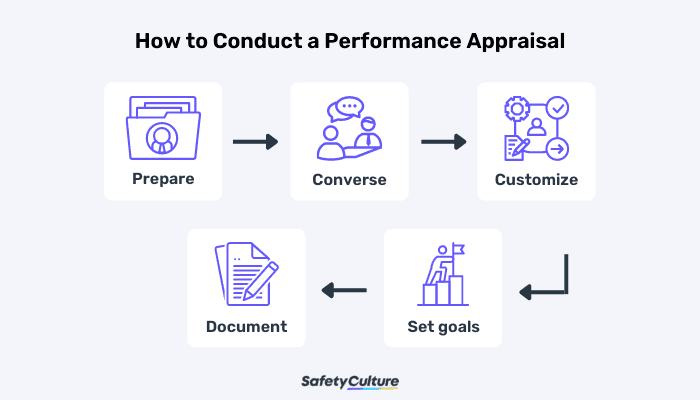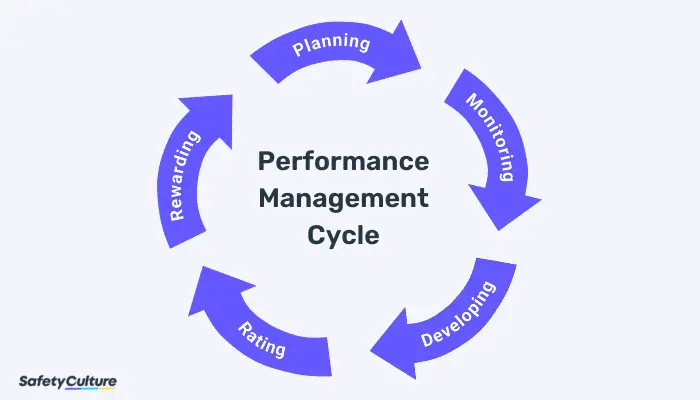What is a Performance Appraisal?
A performance appraisal is a monthly, quarterly, or annual review of an employee’s contributions toward business objectives and company goals. It can help managers identify employee gaps and give them new ideas for training opportunities to boost workplace productivity.
A performance appraisal also serves as an objective avenue for both supervisors and workers to give and receive feedback. Managers may also use it to justify compensation adjustments, bonuses, or even termination decisions. Performance appraisals are primarily used to improve an employee’s performance. It can also be used to justify an employee’s compensation and their potential for promotion. An effective employee performance appraisal process can drive performance, reduce dissatisfaction, identify training opportunities, and boost company culture.
For employees, performance appraisals help them understand where they are in terms of alignment with company expectations and team standards. With a performance appraisal form, supervisors and workers learn more about each other, the business, and themselves.
How to Conduct a Performance Appraisal
Here are 5 tips a manager, supervisor, or HR professional can use to conduct an effective performance appraisal:
- Prepare – ensure you are well prepared by:
- reviewing the notes from the employee’s previous appraisals – You can start by getting a “snapshot” of the employee’s general status and progress by reviewing their last appraisal before comparing it to their more recent works
- reviewing their more recent works – Most employee evaluations are scheduled on an annual or biannual basis, which means their recent works and activity have not been reviewed. Review an employee’s recent works and compare them to
- providing live feedback – Provide on-the-spot positive, and negative feedback instead of waiting for the scheduled appraisal. This shows the employee that you are actually paying attention to their work which will encourage them to be more open and honest during your actual appraisal
- Make it conversational – Having a conversation instead of “lecturing” an employee during a performance appraisal is important because employees are compelled to be open and honest when they feel that they are listened to. Involving the employee in the process encourages engagement and a better understanding of the purpose of the performance appraisal.
- Customize action plans – Action plans must be customized according to each employee’s strengths, weaknesses, target metrics, and personal goals as a member of the organization to be effective. A good action plan must be logical, doable, and directly linked to goals.
- Set effective and realistic goals – An effective and realistic goal should be aligned with the company’s objective, have a time-frame for completion, and an expected output. Employees are more enthusiastic and work harder to meet their individual goals when they understand how it impacts the company’s broader success. Factors such as the nature of the task, the employee’s capabilities, and the tools and support provided such as training and supervisor assistance should all be considered when setting effective and realistic goals.
- Proper documentation – Properly documenting what was discussed during a performance appraisal is essential for practical and procedural purposes. Proper documentation provides you with easy access to employee appraisals should you need to access them. It’s also a common requirement to have employees sign their performance appraisal form as acknowledgement. Using a performance appraisal form can help streamline your performance appraisal process.
Purpose
To lessen organization uncertainty, it is a known business practice to routinely administer appraisals every quarter or as an annual review. One of the most important purposes of conducting appraisals is to manage the performance of your employees. There are so many questions that a supervisor can ask, such as why or why isn’t the company reaching its targets or achieving its goals. Managerial roles are responsible for such questions since they are accountable for their subordinates and their set targets. Knowing the purpose of appraisals will lead to a more effective review process that will, consequently, result in beneficial effects to the company.
The main purpose of a performance appraisal is to know how your employees are doing with their tasks and if these tasks help contribute to the overall business goals. Aside from their workplace duties, information on personal factors such as skills, competencies, and productivity are collected. This activity is recorded using an appraisal form, which makes comparison between previous evaluations easier for supervisors and managers. After rounding up and collating the appraisal forms, managers and supervisors provide feedback to the employees regarding what they did well and what areas need improvement. This allows employees to improve their performance and learn from their mistakes. Another reason why management teams should provide feedback is because it develops better superior and subordinate relationships due to open communication and rational assessment.
There are other performance appraisal objectives that management teams need to consider, including the following:
Set attainable goals for employees – A leader should know an employee’s capabilities and limitations. Review previous tasks and check if the current deliverables are far from each other. A way to set goals is to increase by incremental percentages, which could be taken from the employee’s past appraisals. For new hires, check appraisal records from other employees when they just started and use this as a benchmark or guideline. This is a good way to also review past goals and results.
Determine problematic areas in their key performance indicators (KPI’s) – Employees can have duties that they find difficult or requirements they find challenging to keep up with. Before reprimanding and giving them a low score, reflect first if the set schedule is adequate for the assigned workload. Take note that employees often have other duties and tasks that weren’t part of the KPI’s and they don’t get merit for. Another thing to take into consideration is if they were given clear instructions for the task at hand. Discuss performance with employees to get their insights and see what you can do to help.
Help employees achieve their targets – The me vs. you mindset doesn’t benefit anyone since individual appraisals are evaluated separately and doesn’t affect others’ evaluations. When leading a team, however, their performance affects yours proportionally. People in the group shouldn’t feel like there’s a competition between them since this can pull everyone down and lead to poor team performance. Look at the bigger picture; the company will greatly benefit from managers who assist employees reach their goals.
Motivate employees – After assessing their performance, they should feel more motivated to do their work. Employees should come out of the appraisal wanting to do better on their duties and tasks.
Improve work efficiency and productivity – This objective is one of the end results of employee appraisals. As a team leader, this should be your top priority as it reflects on your own performance.
Outcomes
Analyzing employee evaluations can help management teams identify an employee’s level of competency and productivity. This is also done to select high-potential employees that can be trained for future roles. The results of performance appraisals are utilized for major decision making such as compensation adjustments and promotion. These outcomes affect employees both on a personal and professional level.
Personal Aspect – After experiencing the appraisal process, the employee will be more aware of their strengths and weaknesses. There will be a moment of self reflection they can ponder on. The employee can also pinpoint factors in their personal lives that could be affecting their work performance and productivity. They can use this information to improve themselves and be better persons overall. Another personal aspect is knowing if the employee is in the right mental state or if they are currently stressed, overwhelmed, or depressed. The mental health of an individual has a huge impact in the workplace. The company should look into providing programs that could assist in this type of situation to promote personal and professional growth and enhance performance in the workplace.
Professional Aspect – The numerous benefits of performance evaluations for employees also help towards the company’s growth. After the appraisal, employees should strive for improving their performance. Supervisors are in charge of guiding employees towards this endeavor. A major outcome of performance reviews is the possibility of increase in compensation and higher roles, as mentioned earlier. Another result of conducting appraisals is that supervisors and managers can provide objective feedback for their subordinates. It’s important that superiors be constructive and specific with feedback, then follow it up with advice on how employees can improve. Employees should voice out their concerns regarding work during this process. This will raise any issues that can be resolved by their respective managers.
5 Stages of the Performance Management Cycle
The process for employee appraisals is based on the performance management cycle. Performance management involves more than just getting performance ratings of employees. It follows five stages that direct the entire course of the employee review from start to finish.
Planning
Planning is the first step of performance management. In this stage, supervisors are assigned to set performance indicators and goals to include in the appraisal meeting and forms. This enables better understanding of why, what, and how the appraisal will be done. Employees should be involved as they know their own capabilities. The employees can also talk about tasks and skills they want to be included in the evaluation process. The supervisor can discuss the company’s current performance, situation, and goals.
Monitoring
This stage is where supervisors monitor progress and manage the performance of employees. After setting their KPI’s and goals, the supervisor should make sure that their subordinates are on track and give continuous feedback all throughout. This is an opportunity to steadily work on improving employee performance. The monitoring stage also allows supervisors to identify and resolve any issues early on.
Developing
This stage is used for additional training and development of the employee and is meant to nurture and help the employee improve their performance. The supervisor can advise the employee to take on other tasks and responsibilities that they can learn new skills from. The development efforts will help the employee keep up with the changes in the company and industry.
Rating
This is a critical stage. Some employees may feel apprehensive and anxious during this process for fear of getting a low rating. The previous stages of the appraisal process, however, should have prepared the employee if they were implemented correctly. The supervisor decides on the rating objectively based on the KPI’s and goals of the employee. Supervisors are required to adhere to the company’s procedure on performance rating.
Rewarding
The last stage of the appraisal cycle is providing employees with their just rewards or incentives. Deserving employees should be acknowledged and given merit, certificates, gifts, or monetary rewards. This stage of the appraisal process is when managers decide to give the employee a higher salary or promotion due to their performance. This is a tangible and sincere “thank you” for the employee’s contributions to the company. Providing recognition and incentives boosts employees’ morale and motivates them to do better.
Sure Signs an Employee is Ready for a Promotion
The appraisal process allows you to discern whether an employee deserves a promotion. One of the key signs to look out for is the leadership skills exhibited by the employee. Take note of employees who are known in the organization because they have initiative and are willing to take on more responsibility. Another sign is that the employee makes time to help fellow coworkers even if they don’t have to. If a supervisor can leave the employee on his or her own and trust him or her to get the job done, it’s another sign that the employee might be ripe from a promotion. Employees should be promoted or given incentives when they align with the company’s values and goals and are concerned with the future of the company. These are just some of the signs a supervisor can use and observe in their subordinates. There are other factors to consider, but these will be dependent on your organization’s structure and employee development programs.
Top Reasons why Employees Hate Performance Appraisals
“One in four employees dreads their performance reviews more than anything in their entire working lives,” according to Douglas Stone and Sheila Heen, authors of “Thanks for the Feedback.” This is a sentiment shared by managers.
Most managers, supervisors, and HR practitioners are still struggling to deliver effective performance appraisals. In a survey targeting employees, only 55% of respondents believe that performance appraisals have a positive impact on their organization. Despite the negative feedback, in a separate survey only 30% of respondents said that their organizations made changes to their performance management system in the last three years.
Here are some common reasons why employees may consider performance appraisals ineffective:
- No input from employee – Employees don’t feel like their opinions and suggestions are being valued since their manager does most, if not all of the talking.
- Does not assess actual performance – Evaluations often end up focusing on an employee’s personal traits even if they do not necessarily have a negative impact on their work, instead of their actual contributions and productivity.
- Can be highly subjective – Results rely too heavily on the personal bias of their manager. Factors such as the manager’s mood and personal preference affect the results of what is supposed to be an objective evaluation.
- Managers are not prepared – Some companies have employees working on a different shift from their managers. As a result, employees feel that their managers have not observed them enough to provide an accurate assessment of their performance.
- Too infrequent – Since most companies conduct performance appraisals only once or twice a year with no catch-up sessions in between, employees are only informed of their performance status during the actual appraisal. This can lead to anxiety and defensiveness on the employee’s part.
To address these employee concerns it is vital to prepare a well executed performance appraisal process.
Methods
There are numerous ways to conduct appraisals, this could be done using verbal evaluation, forms, checklists, and scales. Some of these methods of evaluation can be done manually or using a digital format. Supervisors have the option to utilize more than one method and the most common combination is oral evaluation and appraisal forms. As such, supervisors have to foster a good relationship with their subordinates, since oral evaluations can make employees anxious. An advantage of implementing this method is that it’s more personal and both parties can discuss other things that have an effect on their performance. Verbal communication can result in faster corrective action. During an oral appraisal, the employee can open up about challenges they encountered doing their tasks and also issues with their coworkers.
This method needs more attention and can be time consuming, in which case, using appraisal forms can speed up the process. Using appraisal forms is the preferred method since it can be automated, done digitally, and is specific. Printed forms and paper documents, on the other hand, can pile up, get misplaced, and are easily destroyed. Another good thing about digital appraisal forms is that it helps the environment by eliminating the use of paper in the office. They can be filled out with a few clicks and make report generation easy, making the entire process easier and quicker.
Appraisal forms are customized to fit the needs of the company and the employee. There are a wide variety of templates available online for free or for a fee. Remember that any and all information gathered should remain private and confidential, so it’s important that the company have a secure location or server in which to store files. Ideally, appraisal forms should be accomplished prior to an oral evaluation so that the supervisor and employee can have a more fruitful discussion.
Include these Performance Indicators in the Appraisal Form
Performance indicators are used to measure employee performance. These indicators vary per industry, role, and individual. There are many types of work metrics that can measure work quality, quantity, efficiency, and productivity. Supervisors strive for an appraisal that is considered to be objective and transparent. It’s best to discuss with your subordinates the metrics used to measure their performance beforehand. Here are some common performance indicators to include in your employee appraisal forms:
- Attendance
- Using of company resources
- Profit per employee
- Customer feedback
- Total number of tasks completed (within a given timeframe)
- Customer leads
- Average time to complete tasks
Create Your Own Performance Appraisal Form
Eliminate manual tasks and streamline your operations.
Get started for FREEWhat is SafetyCulture and how can I use it for Performance Appraisals?
SafetyCulture (formerly iAuditor) is the world’s #1 digital form application and can help streamline your performance appraisal process. Conduct performance appraisals using your phone or tablet, keep important notes, and assign follow-up actions in real-time. Generate reports instantly on your hand-held device and easily access them online. Get rid of paperwork so you can focus on conducting effective performance appraisals.
To get you started, we have created these free performance appraisal forms you can download, use, and customize for your purpose.
- Perform paperless performance appraisals on your hand-held device
- Instantly generate a performance appraisal report to be shared with your employee and management personnel
- Set a scheduled appraisal date to be sent out to your employees. They will receive a notification on their mobile device.
- Capture electronic signatures
- Take advantage of unlimited, cloud-based storage for all of your appraisal reports.
- Available web-based platform to save storage space and functional to most computers
- Have access to detailed insights and analytics
- Contact with a dedicated support team
To get you started, we have created these free employee evaluation forms, such as 360 feedback templates you can download, use, and customize for your purpose.
FAQs about Performance Appraisal
A formal performance appraisal is mostly done once per quarter as far out as 18 months. Most companies conduct their reviews every 6-12 months. For informal performance appraisals, managers can hold feedback meetings on a weekly basis. This will be a good opportunity for employees to ask questions about their performance, managers to provide coaching and collaborate on problem-solving. It will help both managers and employees to prepare for the formal review.
The responsibility for conducting a performance appraisal lies with the employee’s direct supervisor or manager. Depending on the organizational structure and policies in place, the performance appraisal process may involve multiple individuals, such as HR personnel, peers, senior management, or even the employee being assessed (self-evaluation).
The 4Cs of performance appraisal are communication, critical thinking, collaboration, and creativity. By assessing these key areas, businesses can gain a comprehensive understanding of an employee’s strengths, areas for improvement, and potential for growth.





